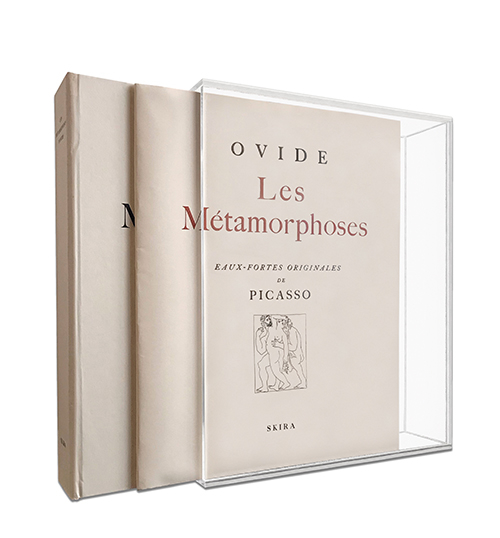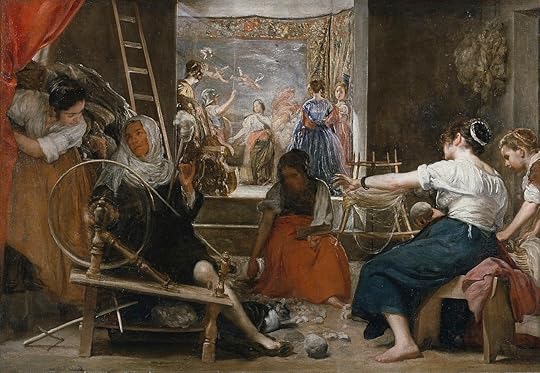 Kalliope’s
Comments
(group member since Aug 28, 2018)
Kalliope’s
Comments
(group member since Aug 28, 2018)
Kalliope’s
comments
from the Ovid's Metamorphoses and Further Metamorphoses group.
Showing 241-260 of 610
 There are a few paintings on Niobe. None, I believe, amongst the very famous.
There are a few paintings on Niobe. None, I believe, amongst the very famous.Below a mannerist rendition using the episode for a display of the male body.
Abraham Bloemaert. 1571. National Gallery, Copenhagen.
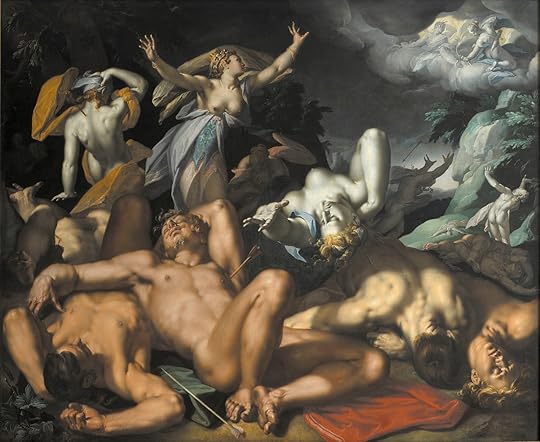
I had never seen this one.
Jacques-Louis David. Niobe trying to shield her children from Artemisia and Apollo. 1722. Dallas Museum of Art.
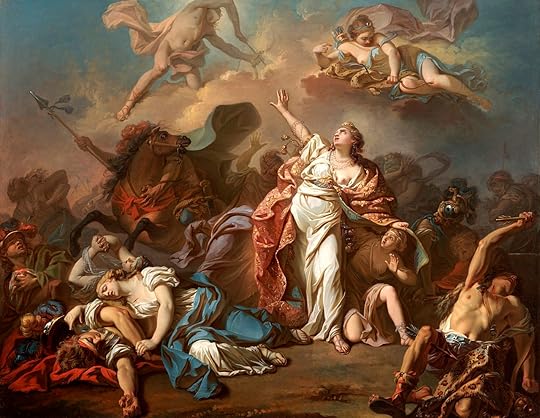
Pierre-Charles Jombert. 1722. Unknown Location.

All pretty powerful, and hard for me to chose amongst them. The Bloemaert is certainly striking.
 More on Niobe. All her seven sons are mentioned individually although they are all killed similarly. We get no names for the daughters.
More on Niobe. All her seven sons are mentioned individually although they are all killed similarly. We get no names for the daughters. My notes elaborate on the effects on Niobe.
Her final metamorphosis into stone is the result not so much of the divine action itself (killing of children), but of the suffering that the divine action caused. It would be a 'natural metamorphosis'.
We get her pathos but not her mathos - that is no learning to accompany her downfall.
We do get her suffering to last into eternity? - but the exact nature of this - regret, sorrow, shock... is left undefined.
 I found the transition from Arachne to Niobe another of those disconcerting Ovidian leaps.
I found the transition from Arachne to Niobe another of those disconcerting Ovidian leaps.The Niobe story took me a second reading because it assumes a fair amount in the part of the reader. First, Niobe's husband, and his art, are alluded to but not mentioned until later, Amphion. My notes say that his art was the lyre. Amphion with his brother Zethus built the wall around Thebes. Niobe later says that the walls of that city were built with music (beautiful idea - the strength of the arts is so constant in this book).
When I though we had finished with Thebes and Cadmus's story, we are back there. And indeed Cadmus is mentioned later when Niobe says that his house is under his power. So, we are in an earlier episode if we were to pay any attention to chronology?
Niobe says she is the daughter of Tantalus. The latter we met in Book IV, when Juno descended into Hades.
My notes tell me more about Tantalus - he had invited the gods to a banquet and served them his own son, Pelops. This story reminded me of Jupiter going to the Lycaon's banquet in Book I.
 Vit wrote: "I’ve got an impression that in the tales of Arachne and Niobe Ovid just ridicules the vainglory and smugness of gods and their unmotivated cruelty too.
Vit wrote: "I’ve got an impression that in the tales of Arachne and Niobe Ovid just ridicules the vainglory and smugness of gods and their unmotivated cruelty too.“Next she design’d Asteria’s fabled rape,
Whe..."
I agree, Vit. Ovid's point of view both in Arachne's and Niobe's stories point to an implicit criticism of the Olympian divinities, but I find him also ambiguous with Arachne and Niobe.
 Elena wrote: "David, your posts on Las Meninas set me to work googling this morning, and the mirror trope is amazing, clearly Velázquez understood the nuances in Ovid's Met. And Kalliope, Las Mininas is too wond..."
Elena wrote: "David, your posts on Las Meninas set me to work googling this morning, and the mirror trope is amazing, clearly Velázquez understood the nuances in Ovid's Met. And Kalliope, Las Mininas is too wond..."Elena, Velázquez took the element of the mirror from Van Eyck's 'Arnolfini Marriage' and developed it further.

The Van Eyck painting belonged to the Spanish Royal Collection back then and Velázquez was the Curator of this collection. (view spoiler).
 An off-topic joke... It plays with the words 'MEninas' and 'MIninas'. The first means the ladies-in-waiting to the princess while the second, as you could guess, means 'female cats'.
An off-topic joke... It plays with the words 'MEninas' and 'MIninas'. The first means the ladies-in-waiting to the princess while the second, as you could guess, means 'female cats'.Someone sent it to me via WA yesterday. I could not resist...haha..

 David wrote: "Yes the mirror but also the fact that Velazquez is looking out at the viewer which he would have done while painting himself. A double mirror. And with the mirror, a true play with reality."
David wrote: "Yes the mirror but also the fact that Velazquez is looking out at the viewer which he would have done while painting himself. A double mirror. And with the mirror, a true play with reality."Yes, he is looking at the viewer, who, from the mirror we realise it is the king and queen, whom, we presume, he is painting in the canvas we only see from the back. But in reality he has been painting the canvas we have in front of us, where the king and queen are not to be seen, except for the reflection.
And as Elena says, on the walls, higher up, are copies of Rubens' paintings - all scenes out of Ovid.
 Fionnuala wrote: "With glowing purple of the Tyrian dye:..."
Fionnuala wrote: "With glowing purple of the Tyrian dye:..."That is a lovely passage.
And it reminded me I wanted to comment on the purple dye. This was the most precious dye back in Roman times and therefore the colour used for framing the gowns of the Senators, and of course, the full gown of the Emperor.
It was extracted from sea snails.
One of those snails in a Roman mosaic.
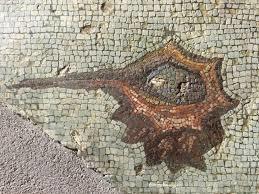
 Jim wrote: "In the Met, pride is condemned and punished not because it's a personal vice per se but rather because it shows disrespect for the superiority of the gods. It's interesting to note that this belief..."
Jim wrote: "In the Met, pride is condemned and punished not because it's a personal vice per se but rather because it shows disrespect for the superiority of the gods. It's interesting to note that this belief..."Yes, it also follows the concept of 'hubris' in Greek tragedy... which the Romans inherited.
 David wrote: "
David wrote: "The image within an image by Velazquez is fantastic. The idea of the women creating images pushes the boundaries. It reminds me of his Las M..."
David, you mean the mirror in the background of the painting?

You could be right, Elena.. I could not find more detail..."
Yes, that's it.. And it is in the Aberdeen Art Gallery.
I will not take it out from the thread, since the weaving in Book VI is also a link to Homer's work. Also, it is a lovely painting.
This then shows that the Arachne has not been a theme too attractive to painters - may be they did not like to depict spiders...
 Elena wrote: "Kalliope wrote: "There are not many more paintings on Arache. I found just a few.
Elena wrote: "Kalliope wrote: "There are not many more paintings on Arache. I found just a few.Herman Posthumus. 1545. No location found
You could be right, Elena.. I could not find more details about it (I always like to know where the work is located nowadays) but that may be why.
Let me search...
As I am becoming more and more interested in Waterhouse's paintings I may search for a book on him.
 Fionnuala wrote: "That last painting catches the color of the threads very well,
Fionnuala wrote: "That last painting catches the color of the threads very well, Into the web they've woven purple threads
of wool that has been dyed in Tyrian tubs,
and hues so delicate that they shade off
each fr..."
What edition are you using, Fionnuala?
 Searching for the images, I found this page that explores the theme of Censorship in Ovid, in particular with the Arachne story.
Searching for the images, I found this page that explores the theme of Censorship in Ovid, in particular with the Arachne story.http://web.colby.edu/ovid-censorship/...
 There are not many more paintings on Arachne. I found just a few.
There are not many more paintings on Arachne. I found just a few.Herman Posthumus. 1545. No location found
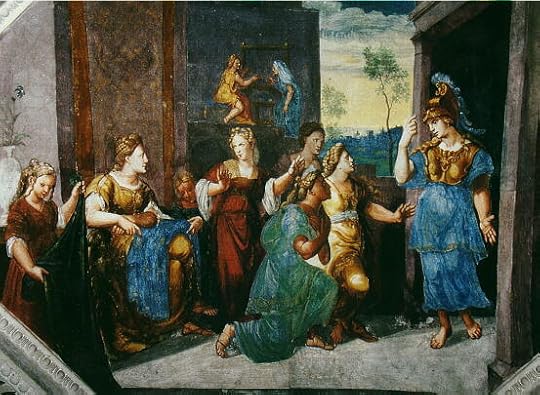
I am less happy with the moment in the narrative chosen for this one. It does not show Arachne's pride, nor the whole scene of Minerva in disguise etc...
René Antoine Houasse. 1706. Versailles.
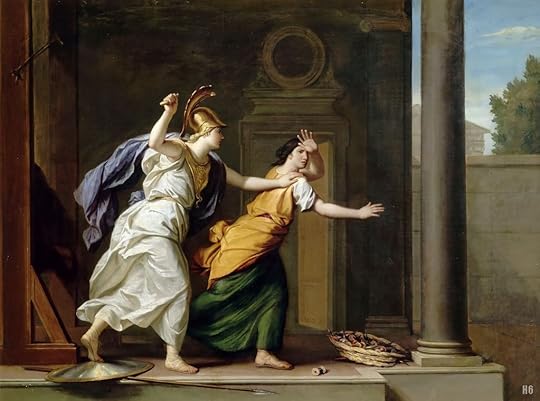
Waterhouse also liked this episode. He certainly got a lot of inspiration from the Met.
John William Waterhouse. 1912.

 I am coming back to Velázaquez's 'The Fable of Arachne' or 'The Spinners'. I already mentioned it when we spoke of Minyas's daughters, wondering whether the scene at the front represented them - or linked the two themes.
I am coming back to Velázaquez's 'The Fable of Arachne' or 'The Spinners'. I already mentioned it when we spoke of Minyas's daughters, wondering whether the scene at the front represented them - or linked the two themes.An illustration of the daughters was at the head of Book VI in the edition of the Met that Velázquez owned.
But now that I have read the account, I am struck by two aspects:
Minerva disguises as an old woman. People often have identified the woman with the spinning wheel as Minerva - and that her uncovered leg, not an 'infirm leg' gives away that she is not an old woman, that she is in disguise. Arachne would be the one on the right seen from the back. And yet, they are not working on looms but on the preparation of the wool, the previous process. While the tool in the back would be part of the tapestry making activities. Furthermore this supposed Minerva is not engaging with the woman on the right but with another woman standing on the far left.
No answers. Velázquez again not illustrating a simple narrative, but using the mythological figures for what seems instead a meditation on art - from the raw materials, to the final work, the tapestries, which in their turn reproduce paintings that were under Velázquez's supervision. And with its allusions to theatre and spectacle.
 Jim wrote: "The story of Arachne gives me an ideal opportunity to talk about Adrian Mitchell’s gorgeous book Shapeshifters: Tales from Ovid's Metamorphoses. Arachne is the final story in the boo..."
Jim wrote: "The story of Arachne gives me an ideal opportunity to talk about Adrian Mitchell’s gorgeous book Shapeshifters: Tales from Ovid's Metamorphoses. Arachne is the final story in the boo..."Thank you, Jim. I am adding it.
 I received from Skira an announcement on the publication of this book...
I received from Skira an announcement on the publication of this book...http://www.skira.net/en/books/ovidio-...
Lovely but on the pricey side... A nice gift.
